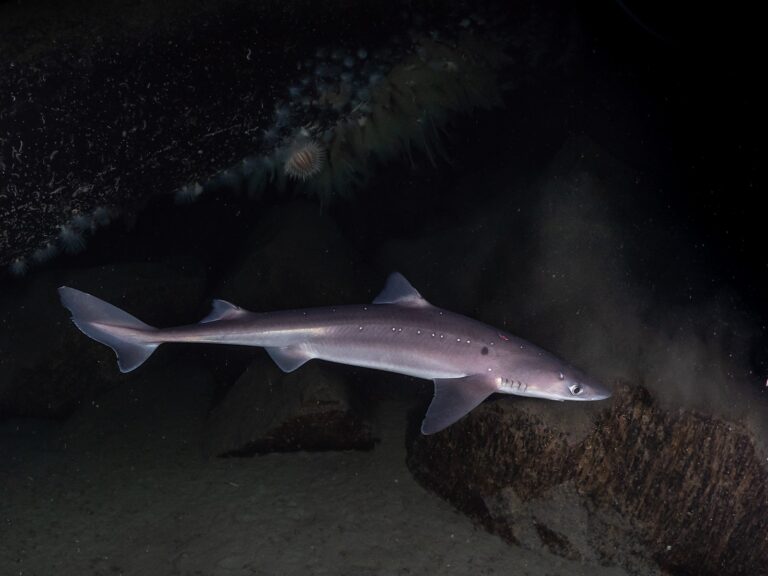Project Description
There is a pressing need to better understand movement patterns and complex life histories of migratory sharks to aid conservation efforts. Life-history characteristics of sharks (late maturity, slow growth, increased longevities, low reproductive output) leave them vulnerable to human exploitation and environmental change. Quantifying resilience to these changes allows us to predict a species´ future response. Information on the routine distribution of such keystone species across habitats during time and space at different stages of their life-histories is unknown, despite advances in tagging technology. To resolve this knowledge gap, this project aims to reconstruct the environmental histories, feeding and movement patterns of the migratory spurdog shark (Squalus acanthias) by utilizing natural biogeochemical ‘tags’ (stable isotopes, trace elements) as environmental/trophic proxies1. Spurdog have suffered estimated biomass declines of >95% due to overfishing and are classed as endangered in the North-East Atlantic and vulnerable worldwide. Between 2010-2022 it was prohibited to commercially fish for spurdog in EU and UK waters. Yet paradoxically when spurdog aggregate they are accidentally caught as bycatch in such large numbers as to be considered a choke species in cod fisheries. This has encouraged limited reopening of the fishery for 2023-2024. Understanding migratory movements, habitat use, and the basis of these aggregations, their composition, and relevance to this species´ marine functional connectivity is crucial to inform policy and for conservation management.
Elements from the environment are incorporated into vertebrae growth rings acting as environmental fingerprints. Trace element analyses using laser ablation will investigate any shifts in habitat use and migration during the lifetimes of individuals. To complement this analysis, the student will use an environmental genomics approach2 to better understand how the genomic characteristics of individuals adapt them to the environmental conditions they experience during their lifetime. Our annotated spurdog genome3 will allow identification and potential function of genes identified by this approach. Understanding the genetic basis of adaptation in spurdog is critical as their aggregations contain closely related individuals and loss of kin groups can rapidly erode genetic diversity of stocks, increasing their vulnerability to climate change. Additional elasmobranchs (white sharks, thornback rays) can be similarly studied, allowing comparison of lifestyles contrasting with spurdog to identify generalizations of ecological life-history reconstructions with genomic markers associated with life-history traits.
Key questions could include: What does a time series of environmental proxies tell us about the habitat(s), locations, migrations, and trophic level(s) an individual experienced during its lifetime? Do estimates of field metabolic rate vary during an individual´s lifetime, with habitat/trophic level, within/between kin aggregations? What associations are there between environmental proxies and genomic data, and how much variation is there within/between recognized aggregations/populations? How do these estimates vary between species, and what ecological/phylogenetic explanations might account for these observations?
This project provides training in core and generic skills, with cutting edge technologies (population genomics, bioinformatics, stable isotopes, multi-elemental fingerprinting) integrating Biodiversity and Earth Systems to translate findings into improved policy and practice for effective conservation management of endangered marine species.
CANDIDATE BACKGROUND
Experience in population genomics/genetics and bioinformatics is essential. Interest in the application of genetics/genomics approaches to conservation is essential. Experience in data handling/statistics is also desirable. An interest in ‘biogeochemical tags’ using analytical chemistry (stable isotopes) and their application of conservation biology is desirable.
Photo credit: Galice Hoarau, Nord University
Supervisors
Catherine JonesPrimary Supervisor: | Profile: Catherine Jones Email: c.s.jones@abdn.ac.uk Institution: University of Aberdeen Department/School: School of Biological Sciences |
Secondary Supervisor: |
Queens University Belfast, School of Biological Sciences Email: n.birse@qub.ac.uk |
Sam MartinAdditional Supervisor: | Profile: Sam Martin Email: sam.martin@abdn.ac.uk Institution: University of Aberdeen Department/School: School of Biological Sciences |
References
1Livernois, M.C., Mohan, J.A., TinHan, T.C., Richards, T.M., Falterman, B.J., Miller, N.R. & Wells, R.D. (2021). Ontogenetic Patterns of Elemental Tracers in the Vertebrae Cartilage of Coastal and Oceanic Sharks. Frontiers in Marine Science, 8, p.704134. https://doi.org/10.3389/fmars.2021.704134
2Delaval, A., Frost, M., Bendall, V., Hetherington, S. J., Stirling, D., Hoarau, G., Jones, C. S., & Noble, L. R. (2022). Population and seascape genomics of a critically endangered benthic elasmobranch, the blue skate Dipturus batis. Evolutionary Applications, 15, 78– 94. https://doi.org/10.1111/eva.13327
3Wagner, C.I., Kopp, M.E. L., Thorburn, J., Jones, C.S., Hoarau, G. & Noble, L.R. (2023). Characteristics of the spiny dogfish (Squalus acanthias) nuclear genome. G3 Genes|Genomes|Genetics, 13 (9), https://doi.org/10.1093/g3journal/jkad146
QUADRAT Themes
- biodiversity
- earth-systems
- environmental-management






















































